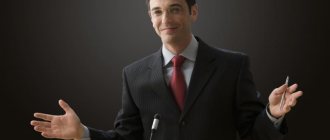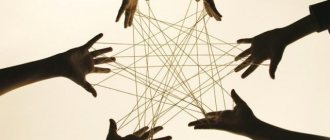Each person during a conversation uses nonverbal signals with which he subconsciously complements or refute what was said. Such signals are involuntary, but with proper training you can learn to control them and recognize the facial expressions of other people.
The psychology of human gestures and facial expressions studies the features of using gestures, various combinations, and the possibility of preventing an emotional reaction. By understanding the main types of reactions and learning to distinguish them, a person will be able to determine whether his interlocutor is telling the truth, his real emotions.
The meaning of gestures
In the human psyche, the meaning of non-verbal signals - gestures and facial expressions - lies in the sphere of the unconscious. People may not pay attention to their own and others' attempts to convey information, but they subconsciously recognize them. To read messages more accurately, it is necessary to study their meaning in accordance with the cultural environment to which the interlocutors belong.
Despite the common meaning of most facial reactions, in some cultures common gestures may have the opposite meaning. Thus, nodding your head usually means agreement, but in some cultures it means denial.
Body language varies depending on the speaker's gender, age, social status and other personal characteristics. Communication using gestures is limited: movements can only convey basic emotions, but it is impossible to show the subtleties of attitude. Therefore, body language is used to complement and enhance the emotional coloring of speech. The conscious use of gestures and control of facial expressions is the result of a volitional effort, aimed mainly at the desire to hide a lie.
Body language and sign language should not be confused. Unlike unconscious muscle reactions, sign language is a full-fledged linguistic unit used for normal communication. The use of sign language allows people with hearing and speech impairments to communicate and socialize successfully.
Origin story
It is not known for certain who created sign language; it has existed for many centuries. But only in the 18th century did they begin to systematize it.
During the industrialization of European cities, groups of deaf people who needed training were concentrated in them.
The Italian doctor J. Cardano was the first to volunteer to teach deaf and mute children using gestures. The languages of the deaf and mute with national characteristics were used as a basis. They became the basis for the foundation of gestural interpretation.
In the modern world, sign language is developing, transforming and popularizing. More and more people want to learn sign language to communicate with colleagues, friends or relatives.
There is an international sign language - zestuno, which is used during international events.
Scientific research
Representatives of Ancient Rome already possessed the study of body language and the desire to characterize gestures. The science formed on the basis of the observations of researchers was called kenesics. The greatest contribution to its development was made by:
- J. Balwer. He created a fundamental work devoted to gestures, in particular, hand movements.
- I. F. Lavater. He studied physiognomy and conducted a comparative analysis of emotions and gestures.
- G. K. Lichtenberg. He published several works in which he examined Lavater’s ideas in detail, calling them superficial and far from reality.
- C. Bell. He studied the nervous system, studied the correspondence of facial features to the emotions experienced. He deduced a pattern between emotional reaction and muscular activity.
- C. Darwin. Studied the correspondence of facial expression to emotional reaction.
- F. Bacon. I came to the conclusion that there is a special body language that is understood by all peoples of the world.
- F. Lowen. In his book on the psychology of the body, he outlined the basics of psychosomatic problems
Psychologists and sociologists believe that body language can become a universal means of communication between people of different social groups.
Where can they help me learn sign language?
Learning gestures on your own is difficult, especially if there is no practice. The following sources will help you during your study:
- youtube. There are many different channels on the YouTube website with video lessons that teach such topics. They analyze the most common phrases and words, provide dialogues, provide voiceovers for films, songs, and much more. Video materials are more interesting to watch, so learning will go faster;
- special sources and books (for example, the “city of gestures” website, where you can learn in the form of a game);
- specialized sign language schools and tutors (Deafnet institution in Moscow, A.I. Herzen Russian State Pedagogical University in St. Petersburg, Institute of Social Rehabilitation in Novosibirsk, etc.). In almost every city there are schools, tutors and institutions that will help you quickly learn sign communication skills.
You can also communicate with people in the form of feedback, who will help you correct mistakes and put your hands in the correct positions. Learning sign language from scratch is not easy, but with diligent effort you can gain complete knowledge and skills.
Learn sign language
Main body segments
When assessing the meaning of posture and movements, you need to pay attention to the segment of the body that gives signals. Each department is responsible for a specific issue:
- eyes - an expression of fear associated with personal relationships;
- mouth - difficulties in communication, fear of rejection;
- neck - negative emotions, anger, aggression;
- chest - suppression of emotional reactions, restraint, self-control;
- diaphragm - social anxiety, volitional efforts, feeling of satisfaction;
- stomach area - feeling of danger, external threat;
- pelvis and groin area - true feelings, intimate interest.
When assessing the reaction of individual body segments, it is always necessary to compare the movements as a whole. Warning should be caused by desynchronization of movements of different departments: a person cannot control his body and it betrays his deception.
Nonverbal Communication
Nonverbal communication is the process of transmitting thoughts without the use of speech - the second signaling system. It absorbs 60–80% of veiled information.
Each of us, when communicating with an opponent who competently sets out the essence of the matter and argues with facts, often feels some kind of catch in his words. But, despite the reliability and veracity of the information, intuition suggests that you should not rely entirely on this person. And with further communication, discomfort is felt, the person is looking for something to complain about.
And, indeed, the interlocutor is betrayed by changes in facial expressions, posture and gestures that contradict his smooth presentation. A certain inconsistency appears and serious concerns arise that he is not acting in your interests at all.
The ability to correctly read the secret language of gestures will help you avoid unpleasant situations. For example, HR specialists cannot do without knowledge about the hidden intentions of potential employees.
It is difficult for a person to hold back emotions for a long time; they must find a way out. But due to circumstances, rules of decency and norms of society, we are not free to surrender to the will of feelings and express them by changing posture, facial expressions and gestures. Often this behavior becomes the norm and turns into a habit.
Gestures of closedness, isolation
For a full psychological assessment of a person based on body movements and gestures, it is necessary to distinguish between shyness and purposeful secrecy. He speaks about reluctance to communicate, fear and hostility:
- Crossing your arms over your chest. While sitting, a person can also cross their legs with their knee forward. This indicates a desire to fence off with armor, to be as far as possible from the interlocutor, distrust and hostility.
- Tightness, hands on knees. A defensive posture, the desire to quickly end the conversation.
- Stomping, tapping fingers, throwing objects from hand to hand. The desire to divert attention from oneself, to avoid a negative reaction.
For many people, secretive postures are comfortable, and they unconsciously adopt them when talking with trusted people. But during business communication they should be avoided so as not to cause misunderstanding.
The history of the appearance of the deaf language
The sign language of the deaf began to emerge in Europe a very long time ago, back in the early 18th century. The main task of teachers of the deaf was to teach hard-of-hearing people how to write and read correctly. In Europe, the old French sign language was mainly used, so it was slightly modified. Teachers were able to introduce new gestures that facilitated grammar learning. At the beginning of the 19th century, this language appeared in Russia.
The World Federation for the Deaf first appeared in 1951, and it was decided to create standards for the language. Standard rules were necessarily applied to all sign languages used by public figures and professionals in working with the hearing impaired.
To standardize gestures, experts carried out long-term work and analyzed the characteristics of all nations. In 1973, they were able to release a full-fledged dictionary of sign speech, prepared by the World Federation.
How to learn sign language
Gestures to help recognize lies
The main thing that any student of body language strives for is the ability to detect lies in the speech of the interlocutor. They say about dishonesty:
- Frequently touching the face, scratching the forehead and nose, covering the mouth with the hand. A person literally tries to stop himself from telling a lie, to cover his face, avoiding a direct condemning gaze.
- Stroking, scratching the neck. Talks about lies caused by fear or misunderstanding. Such gestures are often demonstrated by subordinates when talking with their boss.
- Touching the earlobe. During communication, touching the ears means that the person does not believe in the information he heard, but tries not to show it.
- Quick, frequent smiles, licking lips. It means excitement, a desire to hide deception.
The discrepancy between gestures and spoken words indicates a lie, but individual characteristics must be taken into account. Perhaps the dissonance is caused by anatomical features and is a consequence of the disease. Also characteristic is the discrepancy between movement and words among foreigners who do not know the language well and try to supplement words with gestures.
What other sign languages are there?
Gestures are widely used not only when communicating with the hearing impaired and to convey information to the deaf:
- In special cases, gestures are the object of art, for example, in pantomime. Such nonverbal communication with body movements can be used to poetically reproduce certain situations in life, convey feelings or mood.
- Some types of classical theater in India are accompanied by symbolic gestures that indicate certain actions, phenomena, emotions or objects.
- Classical drama theaters in Japan generally use sign language as an equal part of expression, which has strictly established forms and meanings.
- Gestures are also actively used in the traffic rules system - by traffic controllers, traffic police officers and drivers. Drivers can use gesture signals in situations where indicator lights and turn signals have failed. Gestures from train drivers can warn of a dangerous situation.
- There are established gestures in the army that are used in situations where it is impossible to give commands using the voice, to control the formation and give orders.
- Gestures help during sporting events and referees use signs established by international standards.
Motorist sign language
Gestures warning of aggression
It is important to recognize gestures of aggression and threats in a timely manner - this makes it possible to prevent a conflict in time and get away from the direct line of attack of the interlocutor. An aggressive attitude manifests itself:
- Clenching your fists. The interlocutor speaks in a calm tone, his posture is relaxed, but his hands are constantly clenched into fists - a clear signal of pent-up anger.
- Fists resting on the surface of the table, hips or pressed to the waist - a direct threat, readiness to attack.
- Hands hidden behind back. The person is literally trying to control himself and not show aggression.
- Pursed lips, tightly clenched jaws. They express contempt and dissatisfaction with the interlocutor.
- Scratching the back of the neck and the back of the head. Anticipation of attack, demonstration of readiness for defense.
If during a conversation a person twitches his upper lip, flares his nostrils, squints his eyes, he is ready for open confrontation, demonstrates superiority over his opponent, and threatens.
How to learn to better understand body language?
1. To begin with, you can again look through the album with photographs , especially group ones. Look at how, in what sequence, the characters stand, where they look, how they smile, what their posture is in general, how they relate to each other.
2. The same can be done with other people’s photographs, because in this case, all the characters depicted will be unfamiliar to you.
3. At the next stage, you can start observing the people around you on the street, in a traffic jam, subway, in a cafe or cinema. You risk seeing a lot of interesting things. Suddenly you want to write a book. You never know!
4. Now is the time to observe your own body language. Videos from parties, feedback from loved ones, friends and colleagues can help you with this You will be surprised how what you do differs from how you imagine it. You will have something to work with, although you can leave everything as it is. You decide.
5. News releases, no matter how you feel about them, can serve you well. Your task is simply to turn off the sound and watch the announcer. After a while, even without his words, you will understand where and what exactly is bad in our troubled world.
6. If watching the news is completely unbearable, then films . Just watch your favorite movie without sound. You have the opportunity to catch many shades that you had not noticed before. And if you watch a new film from start to finish, and even without sound, then this is aerobatics!
Doing exercises will help you study certain aspects of body language. But still, the main goal of these trainings is to learn how to use the acquired knowledge in everyday life. Unexpectedly, you will begin to look at the world with different eyes. Over time, through focused searching, you will experience that the perception of signals is now happening consciously, whereas before you did it unconsciously. Watch not only what people say, but also how they say it and how they look.
Stop seeing and hearing only what you would like to see and hear , try to hear and understand what is actually being said. In the end, this will save you a lot of time and save you from a lot of trouble.
original source https://www.domashniy.ru
source
Share on social networks
RќСЂР°РІРёС‚СЃСЏ
Advice from psychologists
An experienced psychologist is able to read the gestures and facial expressions of even a very secretive person and assess his emotional state regardless of verbal information. For people unfamiliar with the subtleties of nonverbal cues, it can be difficult at first to monitor two channels of information simultaneously. You can start with the following techniques:
- note the movements that a person reproduces most often and compare them with spoken words;
- ask your interlocutor leading and clarifying questions, ask the same information several times;
- do not look directly at the interlocutor, look away so as not to arouse suspicion;
- having caught a person in a lie, do not immediately express complaints, do not interrupt the story - perhaps the first conclusions will turn out to be incorrect;
- develop observation skills, learn to compare information.
Special books from which you can glean theoretical information and constant practice will help you learn to understand body language. To learn to read different people, you should constantly train your ability to study emotional reactions, movements, and other nonverbal signals. It is important to compare signals and identify a common series of symbolic gestures. This will help you recognize body signals without thinking in the future.
Interesting Facts
Not even facts, just a few things you need to know. Or interesting to know if you want to familiarize yourself with sign language.
- Sign language varies from country to country. There is an international sign language, but it is little used.
- Deaf people read lips, so it is important for them to see your lips as they pronounce words. Don't be closed off and speak clearly so that they can understand you.
- Sign language uses different grammar and word order. For example, question words are placed at the end of sentences.
- SL has its own linguistic features, structure and grammar. It cannot be said that this is simply a copy of ordinary language transferred to gestures.
- In New Zealand, sign language is the third official language.
Films, TV series, songs and performances are adapted for people with hearing problems. All these materials can be found on the Internet, in particular on YouTube.
Learning sign language is not only useful, but also interesting. You can discover a lot of new things, look at the world a little differently, and help a stranger in a difficult situation.
How to recognize gestures?
To get a complete picture of the correspondence of gestures and facial expressions to a person’s words, you need to evaluate the meaning of all movements:
- Gait. By the way the interlocutor enters the room, you can assess the degree of confidence and self-esteem: a long step, a confident gait - purposefulness and ambition, a shuffling gait - lack of will and aspirations, a slow, imposing gait - narcissism and demonstrativeness.
- Hand position while moving and sitting. Elbows pressed to the body indicate isolation, unsociability; broad gestures, waving your arms when talking - openness, sociability. Touching your interlocutor is a desire to enter the zone of closest trust, a desire to subjugate.
- Direction of view. The position of the eyes shows how interested the interlocutor is in the conversation and the desire to defend his point of view. A downward gaze means the person is telling the truth; an upward gaze means he makes it up as he goes along.
- Posture. A straightened neck and a raised chin indicate a person’s general confidence; a bowed head is a sign of humility and timidity.
- Body direction. A body leaning forward means interest in the conversation, sympathy for the interlocutor, a desire to reduce the emotional distance, and gain trust.
If a person often changes position during a conversation, his opinion is unstable. He is ready to accept someone else's point of view and submit to his interlocutor.
Examples of nonverbal communication
- If a girl, showing off her wrist, communicates with a member of the opposite sex, she lets him know that she is ready to get closer to him. And if he also paints his lips with bright lipstick, then he has truly become the object of her passion.
Read more: How to know that a girl likes you - 14 signs
- There is a common method of establishing contact with new acquaintances: you should copy his gestures and postures. If the interlocutor crossed his arms, you can repeat this body movement. This manipulation promotes non-verbal unity. There is a whole set of such small tricks.
To grasp the true meaning, you need to pay close attention to the position of the interlocutor's hands and feet.
Mainly gestures and postures emphasize the truth, and sometimes contradict what was said.
It is difficult to believe a person with crossed limbs convincing another of good intentions. It is unlikely that he will fulfill his promise. Surely he uses the location and trust of his partners for his personal interests.
Through gestures and posture you can hide some information from your opponents. Despite the casualness and ease of communication, the posture makes it clear that the owner does not intend to share important information with anyone.
Male and female gestures
During a conversation, women tend to gesticulate more often if the subject of discussion is pleasant to them. When discussing unpleasant things or talking with an unpleasant interlocutor, women instinctively strive to move away, shrink, and become smaller. They press their hands, bow their heads, turn away. Expressing interest, women try to come closer, their gestures are open, their palms are turned towards the interlocutor.
Men are less likely to express irritation through gestures. It’s easier to assess their mood through their posture: a relaxed posture speaks of trust, openness, and a desire to continue the conversation. Hunching, squeezing your shoulders, putting your hands in front of you is forming a kind of barrier from an unpleasant interlocutor.
Pantomime, facial expressions, poses
The next group of kinetic means of communication includes facial and pantomimic movements. They are very diverse and also carry information, first of all, about a person’s emotional state, his attitude towards his partner and his assessment of the communication situation.
For example, gait demonstrates the emotional state well. In a dull, sad, depressed mood, a person moves slowly, his shoulders and head are lowered, his arms hang limply along his body, and his legs have difficulty lifting off the ground, so they shuffle. And in a good, cheerful mood, a person walks energetically, his steps are clear and confident, his hands are clearly visible, and his head is raised up.
Features of pantomime
All our body movements are largely related to physiological processes, and pantomime is no exception. For example, when a person is scared, he experiences a feeling of cold, so he involuntarily shrinks, pulls his head into his shoulders, and wraps his arms around himself. His movements become economical, as he tries to “hide” - to be invisible, to take up as little space as possible.
But anger, accompanied by increased muscle tone, is the cause of sudden, sweeping and often poorly coordinated movements. A person can make strong chopping movements with his palm, bang his fist on the table or his palm, or threaten with his index finger. When an angry person writes, the pen sometimes breaks through the paper due to too much pressure and sudden movements.
On the contrary, in a good, friendly mood a person makes smooth, round movements. He is calm, so there is no harshness in his movements, and he is not afraid of anything, which means he is open to the world.
Despite the connection with physiology, a person can control his movements and control pantomime and facial expressions. It is this area of kinesics that is fundamental for constructing a stage image for actors, for conveying the mood and character of the characters.
Politicians are also learning to control their movements under the guidance of psychologists. This is important in order to be able to hide your intentions or demonstrate the right attitude towards your partner and the topic of conversation.
Facial expressions
Facial expressions, as a means of communication, play such an important role that children learn to understand them literally from birth. A 2-3 month old baby already smiles when his mother smiles and cries when she frowns angrily.
A person has 18 main facial muscles, and they, participating in the communication process, are capable of producing a countless number of different movements. It is unrealistic to describe all facial expressions, especially since facial expressions are a reflection of the individual’s individuality, and it is unique for each person. Facial movements create the first impression of a person, because when we meet, we first of all pay attention to the face.
Understanding the meaning of facial expressions, a person learns to control them and monitor the expression of his face. But it is impossible to constantly keep all facial movements under control, and true feelings and intentions still, at least for a moment, break through the artificial mask. For a moment, a person bites his lower lip or involuntarily licks it - this is evidence of anxiety. But the corner of the lips twitched slightly on one side - this is an expression of contemptuous doubt or skepticism.
A special role in facial expressions is played by the eyes, which convey perhaps the most sincere information about a person’s condition. Therefore, people first of all pay attention to the eyes of their interlocutor. You can use them to determine your mood, willingness to help, or desire for revenge. And how the eyes sparkle, literally shine, when a person is in love and looks at the object of his affection! Here are just a few meanings of expressions and eye movements, knowledge of which will help you understand your interlocutor.
- If a person involuntarily looks away, lowering his eyes down, then he is lying, not telling anything or hiding something.
- If, while looking away, your interlocutor directs his gaze upward, but he simply doesn’t know what to tell you, doesn’t know the answer to your question, but doesn’t want you to guess about it.
- If the pupils of the eyes suddenly dilate, then something has greatly frightened your partner.
- If the pupils narrow, and the eyes literally turn into slits, and even the lips compress, be careful - the person with whom you are communicating is angry.
- If your partner's eyes sparkle and he studies your face carefully, then this person is interested in the conversation or in you personally.
- If the eyes are motionless and as if glazed over, and the interlocutor is looking at one point, then this is evidence of shock or deep thought.
- If during the conversation your partner looks away and begins to look at the furnishings or the landscape outside the window, then you should think about stopping communication or changing the topic of conversation - your interlocutor has lost interest in him.
These, of course, are not all the signals that the eyes transmit, but what has been said is enough to understand how important it is to pay attention to their expression.
Poses
Despite the fact that poses are static body positions, they still relate to kinesics. The posture a person takes during a conversation indicates his attitude towards the communication situation and towards his partner.
If people involved in organizing the communication process know the role of movements in communication and follow them, then they pay much less attention to postures. An exception is the most famous pose, which is called closed: a person crosses his arms over his chest, intertwines his fingers or crosses his legs, thereby closing himself off from the interlocutor. This pose is also called protective, although it would be more correct to call it a distancing pose. It is accepted not only in a situation where a person is afraid of a communication partner or feels insecure in front of him, but also when they want to distance themselves from an unpleasant situation. For example, a teacher often sits with his arms crossed over his chest during an exam, and clearly not because he is afraid of the students.
But besides this well-known pose, there are many others. For example, “firth pose,” when a person stands with his hands on his hips. This is a demonstration of self-confidence and superiority, often feigned, if the individual wants to seem more confident than he really is.
There are poses for demonstrating your sexual role. For men, this is a stance with feet wider than shoulder width and hands in pockets, or with thumbs tucked into the belt of trousers. For women, this is a sitting position with legs crossed. And if a lady shakes one leg, then she clearly considers her interlocutor as a potential sexual partner, perhaps unconsciously.
Expressing affection using gestures
By studying body language and gestures, a person can easily understand interest in intimate and romantic relationships. The body movements of women who attract the attention of men are actively expressed:
- demonstration of the wrists, turning the inside of the palms up;
- shaking hair, twirling a curl on a finger;
- licking, biting lips;
- touching the thighs, ankles;
- pointing the toes of the shoes towards the man.
A man, showing interest in a relationship with a woman, subconsciously tries to demonstrate his best qualities:
- stretches up, straightens his shoulders;
- constantly adjusts his tie, cuffs and shirt collar;
- runs his hands over his thighs and knees.
In representatives of both sexes, interest in intimate relationships is revealed by a searching gaze. It glides along the figure of the attractive person from top to bottom, lingering at the neckline and hip level.
Why is it so important to understand people?
• We waste a lot of money or time by hiring the wrong person.
• We lend money to a friend in trouble, and then we find out that he simply took advantage of our kindness.
• A new acquaintance constantly reschedules the meeting, leaving us wondering what is really going on.
• In the world there are thieves, swindlers, philanderers and just people who need to get what they want from us.
These and many other situations require our attention to posture, facial expressions, voice timbre and other characteristics of nonverbal communication.
Microexpressions and involuntary nonverbal cues
Involuntary nonverbal behavior is those contractions of the muscles of the body and face that a person is unable to control.
Consciously telling a lie, trying to hide feelings, a person is nevertheless unable to control the so-called micro-expressions flashing on the face. These are tools of non-verbal behavior that help a specialist psychologist or simply a very observant interlocutor to recognize deception, an attempt to hide information or emotions, since it is impossible to consciously keep muscles from contracting such muscles.
Representatives of certain professions, for which the ability to recognize deception is very important, are taught this ability, or they look for people who are initially predisposed to reading microexpressions. Thus, the ability to detect a lie is extremely important for customs officials, security services, and investigators.
To correctly recognize facial microexpressions, it is important to remember that facial expressions do not express the subject’s thoughts, but feelings, and if disgust flashes on the face for a moment, this does not mean that it is caused by the subject of the conversation - perhaps the person simply has an unpleasant association.











